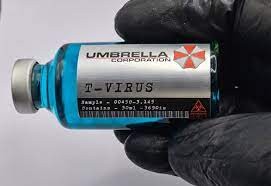
Introduction to Immune System (Pathology)
Why It Is Important: The immune system is the major line of defence in protecting the body against invasion by microorganisms. Issues to be covered: 1. Structure and function of the immune system 2. Innate and adaptive immunity 3. Cell mediated and humoral immunity The student should be able to: Describe the differences between innate and adaptive immune systems Name the cells and molecules involved in adaptive and innate immunity and describe their function Describe how cell-mediated and humoral immune responses protect against infection Describe the differences between cell-mediated and humoral immunity.
-
Immunology is the study of what?
It is the study of our body's system for preventing disease
-
What is innate immunity (3)?
-Front line defence.
-Includes barriers preventing microbe entry, secretions, resident/circulating cells, complement proteins, and cytokines.
-Immediate, non-specific, no memory
-
What is Adaptive immunity (3)?
-Specific and memory responses.
-Humoral (B cells, antibodies) and Cellular (T cells).
-Takes days-weeks to develop but is potent and highly specific
-
What are the 5 main components of the innate immune system?
Components:
-Epithelial barriers (skin, GI tract, respiratory tract).
-Secretions at mucosal surfaces.
-Cells (mast cells, neutrophils).
-Circulating proteins (complement).
-Locally produced cytokines (interferons).
-
What are the 2 functions of the innate immune system?
Function:
-Immediate and early protection.
-No memory, non-specific response to repeated challenges.
-
How is danger detected in the innate immune system?
Detection of Danger:
-PAMPs and DAMPs recognized by Pattern Recognition Receptors (PRRs) on immune cells.
-
What is a PAMP? (Definition, examples and function)
PAMPs (Pathogen-Associated Molecular Patterns):
Definition: PAMPs are molecular motifs or patterns that are conserved within a class of microbes but are not present in the host organism.
Examples: Glycans, lipopolysaccharides, bacterial flagellin, lipoteichoic acid, peptidoglycan, and nucleic acid variants associated with viruses (e.g., double-stranded RNA).
Function: PAMPs are recognized by Pattern Recognition Receptors (PRRs) on immune cells, triggering immune responses. They act as signals indicating the presence of potential pathogens.
-
What is a DAMP? (Definition, examples and function)
DAMPs (Pathogen-Associated Molecular Patterns):
Definition: Damage-Associated Molecular Patterns (DAMPs) are endogenous molecules that are typically sequestered within cells.
Example: One example of a DAMP is High Mobility Group Box 1 (HMGB1). HMGB1 is a nuclear protein that is normally present inside cells, where it functions in the regulation of DNA structure.
Function of DAMPs: DAMPs are like alarm signals released by damaged or stressed cells. When cells are in trouble (due to injury, infection, or stress), DAMPs act as signals to alert the immune system. Their main jobs are to kick-start inflammation, which helps the body get rid of damaged cells, and to promote the repair of tissues. DAMPs essentially guide the immune system to areas where there's a problem, ensuring a quick and targeted response to potential threats.
-
What is phagocytosis and nae some professional phagocytes?
Process:
Internalization of solid matter, including microbial pathogens.
Professional phagocytes: neutrophils, macrophages, dendritic cells.
Vital for innate and adaptive immune responses.
Cell Types:
Neutrophils (circulation).
Macrophages (tissues).
Dendritic cells (skin).
-
What is the function of inflammation? what is it triggered by and what are the main events that occur?
Inflammation
Triggered by:
PRRs recognizing PAMPs or DAMPs.
Release of cytokines from white blood cells.
Main Events:
Increased blood supply.
Increased vasculature permeability.
Migration of WBCs into affected tissue.
Function:
Concentrates immune cells to infection or damage sites
-
What are the 4 components of the adaptive immune system?
Components:
-Dendritic cells (antigen presentation).
-T lymphocytes (helper and cytotoxic).
-Cytokines (control activities of other cells).
-B lymphocytes (produce antibodies)
-
Why is the adaptive immune system important? (2)
Importance:
-Potent, specific, and allows for memory of pathogen.
-Defence against infection if innate immunity breached.
-
What is the definition of the lymphoid system?
Definition:
The lymphoid system is a network of tissues and organs that contains cells involved in the immune response. It includes lymphoid organs, lymph nodes, tonsils, spleen, and thymus.
-
What is the function of the lymphoid system?
Function:
The primary function of the lymphoid system is to generate an immune response against pathogens (such as bacteria, viruses, and fungi) and abnormal cells (including cancer cells). It also plays a role in immune surveillance and the removal of damaged or aging cells.
-
What are the components of the lymphoid system? (primary and secondary lymphoid organs)
Components:
Primary Lymphoid Organs:
These are sites where white blood cells (lymphocytes) mature and differentiate. Examples include the thymus (T cell maturation) and bone marrow (B cell maturation).
Secondary Lymphoid Organs:
These are sites where immune responses are initiated. Lymph nodes, tonsils, and the spleen are examples of secondary lymphoid organs
-
What is the definition of the lymphatic system?
Definition:
The lymphatic system is a network of vessels, nodes, and organs that transports a clear fluid called lymph. Lymph is derived from tissue fluid that bathes the body's cells.
-
What is the function of the lymphatic system?
Function:
The primary function of the lymphatic system is to maintain fluid balance in the body and facilitate the immune response. It collects excess tissue fluid, filters it through lymph nodes, and returns it to the bloodstream. Additionally, it transports immune cells and proteins throughout the body.
-
What are the components (5) of the lymphatic system?
Components:
Lymphatic Vessels:
Thin-walled vessels that transport lymph. They parallel blood vessels and collect excess tissue fluid.
Lymph Nodes:
Small, bean-shaped structures that filter and purify lymph. They contain immune cells and are important sites for the initiation of immune responses.
Spleen:
An organ that filters blood and removes damaged blood cells. It also contains immune cells and participates in immune responses.
Thymus:
A gland where T lymphocytes mature and differentiate.
Tonsils:
Clusters of lymphoid tissue in the throat that contribute to immune defense against pathogens entering through the mouth and nose
-
Adaptive Immunity - Recognition of Foreign Antigen; what is the process (2)? and what molecules are involved (2)?
Molecules Involved:
-Immunoglobulins (antibodies).
-T-cell antigen receptors (TCRs).
Function:
-Antibodies produced by B cells (humoral immunity).
-TCRs on T cells recognize processed antigen fragments.
-
What are immunoglobulins?
•Immunoglobulins (antibodies), are glycoproteins produced byplasma cells. They specifically recognise and bind strongly toparticular antigens on pathogens, and prevent disease or aid inthe destruction of the pathogen.
•There are different classes and subclasses of immunoglobulins,which differ in their structure, biological features anddistribution.
•Immunoglobulins are produced by B cells (differentiates into plasma cells) – humoral immunity
-
What are T-call antigen receptors?
•T-cell receptors are found on the surface of T cells. They are responsible forrecognizing processed fragments of antigen (peptides) which are“presented” by host cells. The binding between TCR and antigen peptides isrelatively weak compared to antibodies.•When the TCR engages with antigenic peptide, the T lymphocyte isactivated through a series of biochemical events (signal transduction),leading to cell proliferation and biological activity (eg cytokine production).•TCRs are produced by T cells – cellular immunity
-
What are antibodies?
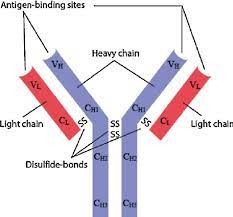
• Antibodies are glycoproteins that are made by B cells and plasma cells.• They bind specifically and with high affinity to “non-self” antigens.
• Antigens are usually proteins or carbohydrates attached to, or secreted by, microbes and infected cells.
• Antibodies can neutralise targets, or recruit other components of the immune system to kill targets
-
What are T cells? (cell mediated (cellular immunity)
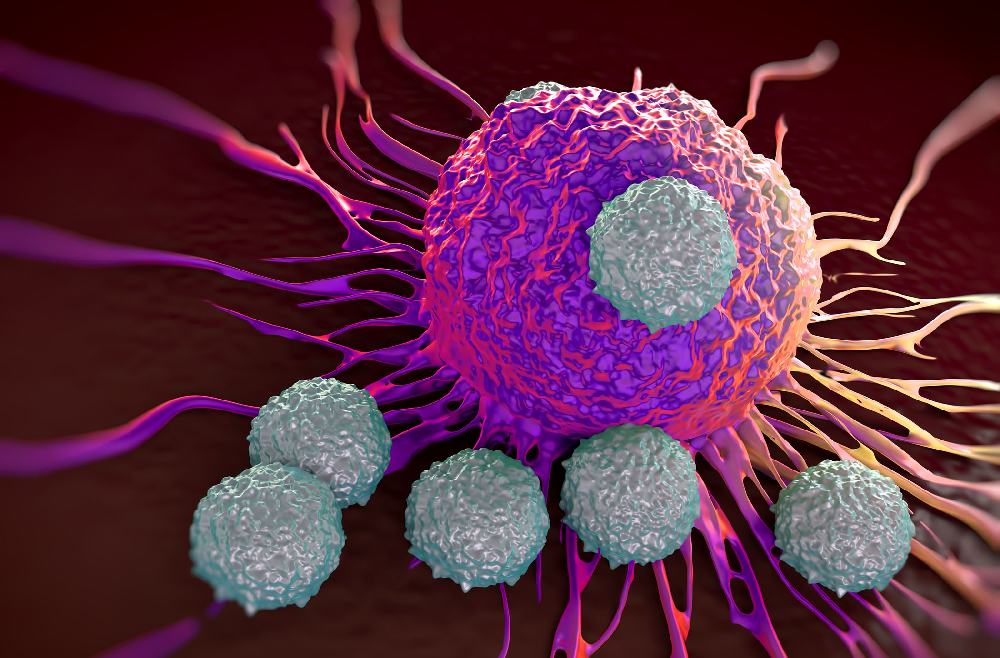
• T cells control the immune response and combat microbes that are inside cells (intracellular).• Different T cells have different functions and are distinguished by the array of proteins on the cell surface (Cluster of Differentiation – CD – markers).
• Two major groups are CD4 (helper T cells), and CD8 (cytotoxic T cells
-
How do t cells recognise antigens?
-T cells recognise antigens via cell-surface receptors (TCRs) proteins, that are related to antibodies.
-But unlike antibodies, T cells do not recognise foreign molecules in their “native” state
-
T cells only recognise antigens that have been what....?
-T cells only recognise antigens that have been processed within cells, and that are displayed on cell surfaces.
+For example, antigens derived from pathogens that have infected cells, such as viruses or intracellular bacteria, or from pathogens that have been phagocytosed by antigen presenting cells like macrophages and dendritic cells.
+In both cases, foreign antigen fragments (peptides) are displayed at the cell surface by molecules of the major histocompatibility complex(MHC).
-
Describe the two types of responses that can occur after T cell activation?
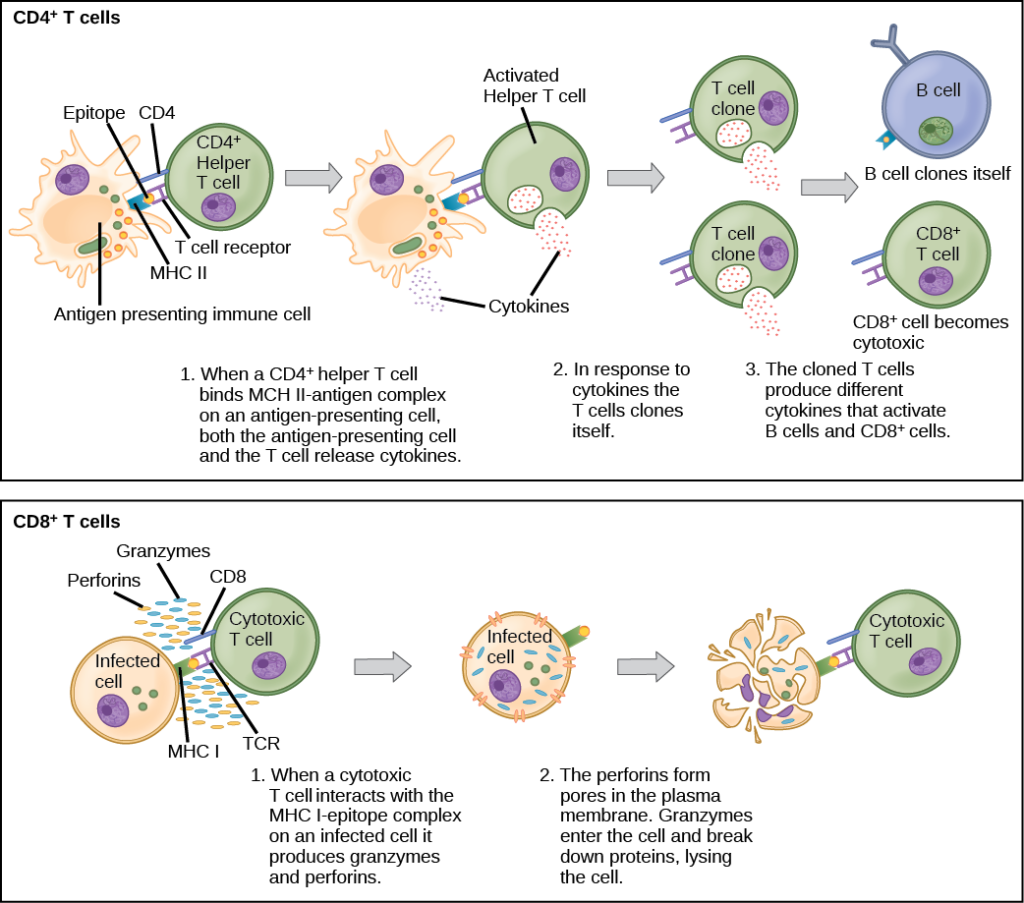
-Depending on how antigen is presented, different T cells are engaged, leading to differentT cell responses
+Mature helper T cells secrete cytokinesto “help” (activate) macrophages, Bcells and other T cells
+Mature cytotoxic T cells killtarget cells using cytokines,cytotoxic granules and thecaspase cascade
-
What are the antibody features and examples relating to immunological techniques
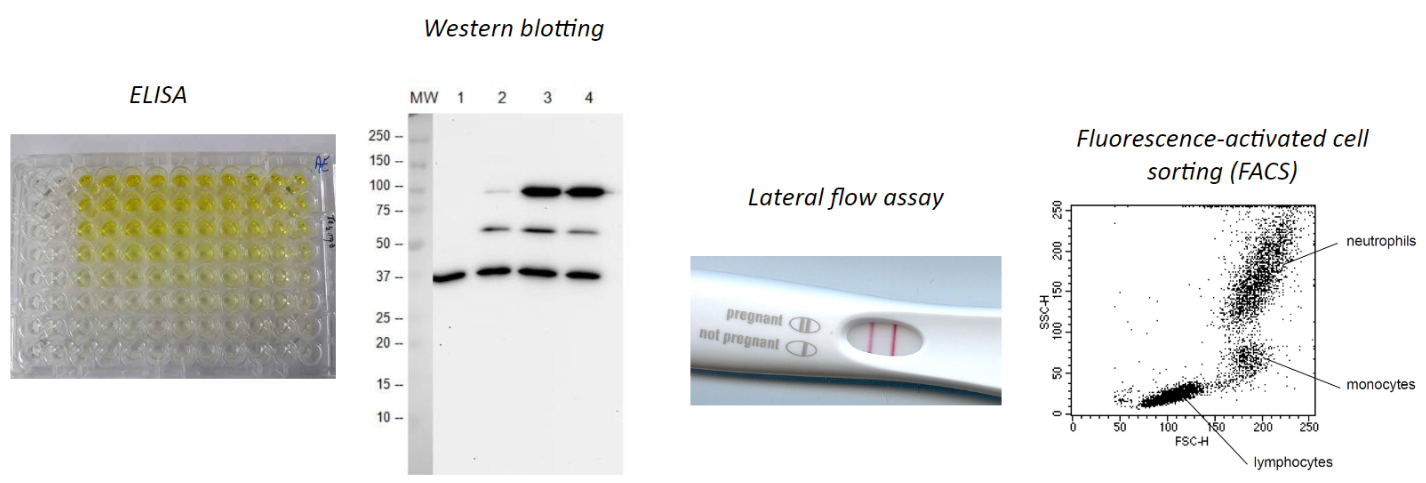
Antibody Features:
Antigen specificity and high affinity.
Valuable in laboratory assays.
Examples:
FACS, lateral flow assay, Western blotting, ELISA

